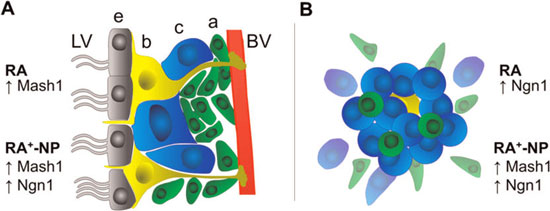| Posted: Dec 06, 2012 | |
Nanoparticles to control the differentiation of neural stem cells inside the brain |
|
| (Nanowerk Spotlight) The subventricular zone (SVZ) is a region in the mammalian brain where self-renewing and multipotent neural stem cells give rise to new brain cells such as neurons, astrocytes, and oligodendrocytes. Neuroscientists and cell biologists are keen to use nanotechnologies to manipulate endogenous stem cell niches such as the SVZ. | |
| New work, published in the November 23, 2012 online edition of ACS Nano ("Polymeric Nanoparticles to Control the Differentiation of Neural Stem Cells in the Subventricular Zone of the Brain"), first-authored by Tiago Santos, a PhD student now at UCLA, describes the first example in the manipulation of the neural stem cell niche by the use of nanoparticles releasing a pro-neurogenic agent – retinoic acid. | |
| "We believe that the manipulation of these niches might open new perspectives for the treatment of neurodegenerative diseases," Dr. Lino Ferreira, a principal investigator at the Biocant-Center of Innovation and Biotechnology in Portugal and Dr. Liliana Bernardino, a principal investigator at the University of Beira Interior in Portugal, tell Nanowerk. "Our nanoparticle formulation is very promising to drive the neuronal commitment of SVZ neural stem cells both in vitro and in vivo and offers new opportunities to treat neurodegenerative diseases." | |
| Retinoic acid was found to be a molecule of great importance to modulate neurogenesis – the process by which neurons are generated from neural stem and progenitor cells – and it has proven to be capable of inducing neurite outgrowth and neuronal differentiation from various cell sources. | |
| However, retinoic acid is rapidly metabolized by cells, has low solubility in aqueous solutions, and requires a fine-tuning of concentration window to achieve its results, posing difficulties in the delivery of therapeutic doses. | |
| Nanoparticles can be a powerful strategy to overcome these limitations by ensuring controlled release of retinoic acid, as demonstrated by the Portuguese team. | |
 |
|
| Dynamics of initial stages of differentiation between SVZ cells treated with RAþ-nanoparticles (NP)s and solubilized retinoic acid (RA). (A) In vivo, the SVZ contains a subpopulation of neural stem cells, or type B cells (b; yellow), that contact with ependymal cells (e; gray), the ventricular lumen and blood vessels (BV; red). Type B cells give origin to rapidly dividing transit-amplifying C cells (c; blue), which in turn generate neuroblasts or type A cells (a; green). These neuroblasts will ultimately differentiate into mature neurons. Upon i.c.v. injection with solubilized RA or RAþ-NPs, the SVZ population overexpresses Mash1 and Mash1/Ngn1, respectively. (B) In vitro, SVZ cells form neurospheres, mainly composed by EGF-responsive type C cells (blue). Under differentiation conditions, neurospheres give rise to a mixed population of progenitors in different stages of differentiation, neurons, oligodendrocytes, and astrocytes. Upon treatment with solubilized RA or RAþ-NPs, the SVZ population overexpresses Ngn1 and Mash1/ Ngn1, respectively. (Reprinted with permission from American Chemical Society) | |
| Ferreira and Bernardino summarize three main points of this work: "First, we demonstrate the differentiation mechanism mediated by retinoic acid released from a polymeric nanoparticle within neural stem cells. Our results show that retinoic acid released from nanoparticles interacted with retinoic acid receptor (RAR), activated SAPK/JNK signaling pathway, and induced the methylation of histone lysine residues which in turn associated with the promoter regions of proneurogenic genes such as Ngn1 and Mash1. | |
| "Second, we report for the first time a nanoparticle formulation that can be used in vivo to control the differentiation of neural stem cells. Notably, our formulation offers a significant advantage over free solubilized retinoic acid, either by avoiding the use of solvents like DMSO, and by achieving a proneurogenic effect with a retinoic acid concentration ~2500-fold lower than the one needed with free retinoic acid. | |
| "Third, our study is the first to show the dynamics of the initial stages of stem cell differentiation either in vitro or in vivo after exposure to a formulation of nanoparticles containing a biomolecule or a solubilized biomolecule. The study of the differentiation profile of stem cells in both conditions is important to design more effective formulations to modulate the stem cell niche. Our results show that retinoic acid-loaded nanoparticles were more robust in maintaining the signature of gene expression (although with different kinetics) either in vitro or in vivo than solubilized retinoic acid." | |
| Ferreira notes that the ability to control stem cell activity in vivo remains a particular challenge that should be further explored in the near future. | |
 By
Michael
Berger
– Michael is author of three books by the Royal Society of Chemistry:
Nano-Society: Pushing the Boundaries of Technology,
Nanotechnology: The Future is Tiny, and
Nanoengineering: The Skills and Tools Making Technology Invisible
Copyright ©
Nanowerk LLC
By
Michael
Berger
– Michael is author of three books by the Royal Society of Chemistry:
Nano-Society: Pushing the Boundaries of Technology,
Nanotechnology: The Future is Tiny, and
Nanoengineering: The Skills and Tools Making Technology Invisible
Copyright ©
Nanowerk LLC
|
|
|
Become a Spotlight guest author! Join our large and growing group of guest contributors. Have you just published a scientific paper or have other exciting developments to share with the nanotechnology community? Here is how to publish on nanowerk.com. |
|
